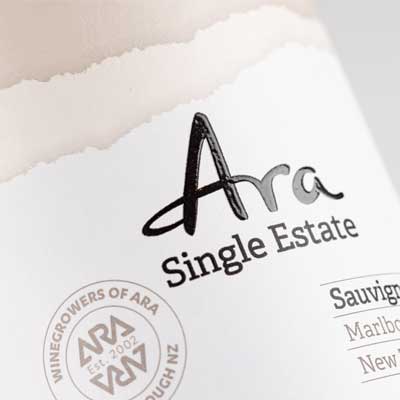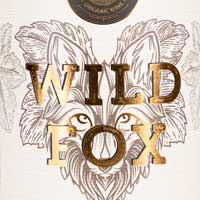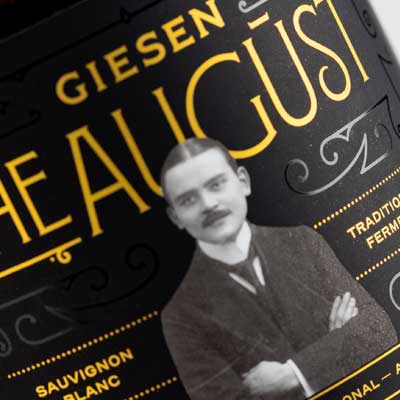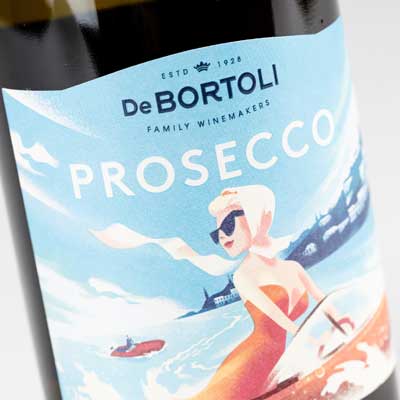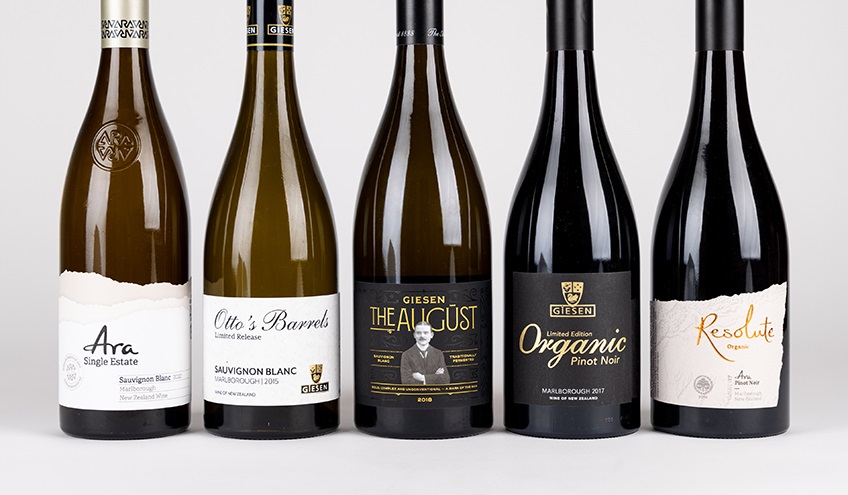
12 tips for printing a distinctive wine label
Great labels will sell your wine.
Have you wondered how to help grab more consumer attention for your wine? Or pondered what else you could do with your label to create the right brand message? Let us share with you 12 tips for choosing the best label printing techniques to ensure your wine stands proud on the busy retail shelf.
Consumers are presented with a dizzying array of wine options in store and the label on your bottle is the key influencer in this vital decision-to-purchase moment. This is particularly true for younger wine consumers and first-time brand purchases. In the absence of a taste test, the wine label provides helpful cues as to the wine’s quality, taste, provenance, price and occasion. The right label will grab the attention of your target consumer, it will create a positive emotional connection and give a reason to choose that wine over any other.
Read on to learn about the various options available to you for printing a distinctive wine label for your brand.
Whilst we don’t claim to be designers, there are some common themes we see our customers using to create an outstanding label design…
1. Personalisation – Customised label solutions
Digital label printing has significantly transformed the way we can engage and connect with consumers, offering personalisation like never before. Digital personalisation is fast and flexible, and is perfect for small to medium high quality print runs. There are two main forms of personalisation:
- Printing variable components within a label design either randomly or via a database, such as text, images, numbers and barcodes e.g. a unique number or name on each label
- MCC Personalisation, a software program unique to our HP Indigo presses that provides the opportunity to create countless individual designs where no two designs are alike
Personalisation can create a key point of difference in the market, whilst creating a strong emotional connection with the consumer.
2. Medal Labels – Show off your achievements
Wine medal labels are often used by consumers as a helpful shopping guide, and can be a great way to communicate the quality of your wine. These can be applied as a separate label for one or multiple medals, or can be included in your main label design. The key to using medal labels is authenticity and trust, so make sure to follow industry guidelines on best practice such as the Australian Grape & Wine Industry Display of Awards Code of Practice.
3. Embellishment Selection – Wise choices pay off
A few choice embellishment details and you can really take your wine label to the next level in terms of attention to detail and crafting the right vibe. Simplicity is sometimes the key to creating a show-stopping custom label that communicates a classic and elegant look. On the other hand, over-styling your label with multiple elements and embellishments can be perfect for handcrafted and quirky brand personalities. Read on to learn more about each of the embellishment options.
Next up is enhancing your label from an array of embellishment and finishing options…
4. Embossing – Create a tactile experience
Embossing (and debossing) adds a textured, prestigious effect to wine labels by raising (or lowering) a pattern or image from the label surface. This gives a tactile feel and can highlight certain design elements. Embossing is particularly effective on uncoated papers.
5. Foiling – An elegant finish
Adding foil achieves a premium, luxurious effect that communicates quality and complements the label design. Foiling will give your label instant metallic shine and reflective depth, giving the label a distinct finish. Depending on the desired look, we can use cold foil or hot foil, and at times no foil at all – instead a metallised material may work best. Foils aren’t just available in gold and silver but also come in a rainbow of colours and designs such as holographic patterns.
Texture Foil is a stunning new embellishment, combining the best of embossing and foil to create a raised and textured foil effect.
6. High Builds – Highlight your design
High build coatings give a tactile, premium effect that highlights key design areas. They act as a clear or coloured raised surface on areas of your wine label such as your logo, variety name, or as a textured pattern. They can also be very effective when used as a super glossy highlight over a matte finish background. It is also a good way of enhancing the richness and depth in colour of the chosen design elements. Available as low, mid, high or braille builds.
7. Silk Screen – Simple yet impactful
Silk screens print a smooth, controllable lay-down of high density, opaque ink for chosen design elements. This gives excellent depths of spot colours and is particularly effective when using a white either on its own or to provide a base for vibrant printed design elements. Silk screens create bold colours that pop off the label, plus the ink creates a raised, tactile feel.
8. Flawless Finishes – Enhance and protect your label
Not only do finishes protect your label from moisture and scuffing, they can also enhance their appearance. Most labels have a glossy or matt finish, which can be achieved with either a coating or a lamination. We can do a flood coating all over the label, and we can also do a spot coating over an element of the design to highlight it or to create a pattern. A very effective look can be achieved by using contrasting gloss and matt finishes in different areas of the label. Tactile coating options include soft touch, textured, and sandpaper. There are also countless specialty coatings such as thermochromic, scented, scratch off, glow in the dark and glitter that we can use to achieve outstanding results.
Don’t forget the basics – the right material, adhesive and label shape and size are critical to achieving the right look…
9. Material Selection – For both looks and performance
There are innumerable material options to choose from. From glossy paper to textured uncoated stock, or clear film for a “no-label look” and even metallised for a distinctive shine. When selecting a material there are different factors that should be considered; how it works with the bottle, label application method, ice bucket performance, compatibility with the artwork, and whether it suits your brand. We have an extensive selection of specialty wine stocks available, including our two premium options, Pelorus and Birrabeen, which are cream and white uncoated textured materials (contact us for a sample). Pelorus, Clarence, Natural Kraft, Black Vellum and Pearlescent Patterned Paper are just a few more. Or if your brand has an environmental or organic connection, why not choose an environmentally friendly material? There are plenty of options available, whether it’s recycled content, chain of custody certified, biodegradable, or made from unique waste products like sugarcane or limestone.
10. Adhesives – Performance from bottling to consumption
There are many different types of label adhesives, and each perform their best in differing conditions. No one adhesive is the best at everything. You will need to know what your label will be stuck to, such as glass or plastic. Will it be applied when the bottle is wet or dry? Do you want the label to be repositionable, removable or permanent? Will it go into an ice bucket, kept in the fridge or stored at room temperature? It’s important to understand exactly what you need, so we can choose the right adhesive for you.
11. Shape and size – Size does matter
The most common wine label shape we print is a rectangle as it allows for more design space and easily wraps around the bottle. However, we can print many other shapes to add a unique touch to your labels such as round, oval, diamond, shields or even custom shapes. No need to stick with straight edges either, why not try an uneven, feathered edge for a natural look? Two-part label shapes are also a great option. Further, Size Me Up is a great tool to quickly and easily work out your wine label size based on the bottle you use. Additionally the New Zealand Wine Packaging Forum recently released two helpful documents regarding wine labelling:
NZ Wine Packaging Forum guide for wine labels - This document is a guide to wine labels to ensure an optimal labelling outcome.
NZ Wine Packaging Forum wine label size and position templates - This document contains templates of all NZ wine bottles, with the optimum label size and placements for labels on these.
And finally, which is the best technology to print your labels?
12. Print method – Is digital or flexo best?
Digital label printing is popular among many wineries as it is ideal for printing short runs, multiple varieties and frequent changes. Flexographic label printing, however, is better suited for larger volume runs. This can be more economical, especially if you will be ordering the same label regularly. Deciding which is the best print method involves considering many variables (take a look at our handy flexo vs. digital label printing infographic to learn about the key differences). Ultimately we can recommend the best manufacturing method based on your unique needs.
There is a lot to consider when printing the perfect wine label, but remember that you aren’t on your own. Our team of wine label experts work with a broad range of clients, from the smallest boutique wineries right through to major brands. Our extensive selection of materials and embellishments is combined with our technical expertise to provide exceptional service.
For more handy resources check out our blog post Wine Labelling Resources You Need to Know (The Complete List).
We have wine label printing experts at all our sites; Auckland, Brisbane, Christchurch and Sydney plus our Melbourne sales office. Our team are standing by now to help you create a custom wine label solution that will create a distinctive look for your brand.


 1800 773 331
1800 773 331 0800 152 162
0800 152 162